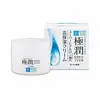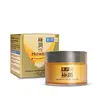What's inside
What's inside
 Key Ingredients
Key Ingredients

 Benefits
Benefits

 Concerns
Concerns

 Ingredients Side-by-side
Ingredients Side-by-side

Water
Skin ConditioningGlycerin
HumectantDipropylene Glycol
HumectantDiglycerin
HumectantSqualane
EmollientCaprylic/Capric Triglyceride
MaskingSodium Hyaluronate
HumectantPhytosteryl/Octyldodecyl Lauroyl Glutamate
Skin ConditioningCarbomer
Emulsion StabilisingStearyl Alcohol
EmollientBehenyl Alcohol
EmollientPEG-20 Sorbitan Isostearate
EmulsifyingGlyceryl Stearate
EmollientMelaleuca Alternifolia Leaf Oil
AntioxidantDisodium EDTA
Dimethicone
EmollientMethylparaben
PreservativePropylparaben
PreservativeWater, Glycerin, Dipropylene Glycol, Diglycerin, Squalane, Caprylic/Capric Triglyceride, Sodium Hyaluronate, Phytosteryl/Octyldodecyl Lauroyl Glutamate, Carbomer, Stearyl Alcohol, Behenyl Alcohol, PEG-20 Sorbitan Isostearate, Glyceryl Stearate, Melaleuca Alternifolia Leaf Oil, Disodium EDTA, Dimethicone, Methylparaben, Propylparaben
Water
Skin ConditioningGlycerin
HumectantHydrogenated Polyisobutene
EmollientButylene Glycol
HumectantDipropylene Glycol
HumectantDimethicone
EmollientBehenyl Alcohol
EmollientTribehenin PEG-20 Esters
EmollientButyrospermum Parkii Butter
Skin ConditioningHydrogenated Castor Oil Dimer Dilinoleate
Skin ConditioningPentylene Glycol
Skin ConditioningPanthenol
Skin ConditioningNiacinamide
SmoothingLimnanthes Alba Seed Oil
Skin ConditioningHydroxyacetophenone
AntioxidantBetaine
HumectantOenothera Biennis Oil
EmollientHydroxyethyl Acrylate/Sodium Acryloyldimethyl Taurate Copolymer
Emulsion StabilisingCaprylic/Capric Triglyceride
MaskingTitanium Dioxide
Cosmetic ColorantSqualane
EmollientTocopherol
AntioxidantXanthan Gum
EmulsifyingSodium Stearoyl Glutamate
CleansingDipotassium Glycyrrhizate
HumectantHydrogenated Phosphatidylcholine
EmulsifyingDisodium EDTA
Ubiquinone
AntioxidantPolyhydroxystearic Acid
EmulsifyingAluminum Stearate
Cosmetic ColorantBisabolol
MaskingPolysorbate 60
EmulsifyingAlumina
AbrasiveHippophae Rhamnoides Oil
EmollientEuterpe Oleracea Fruit Oil
Skin ConditioningRubus Idaeus Seed Oil
EmollientOxycoccus Palustris Seed Oil
AntioxidantCalophyllum Inophyllum Seed Oil
AntimicrobialSodium Hyaluronate
HumectantHydrolyzed Sodium Hyaluronate
Skin ConditioningCarnosine
Skin ConditioningSorbitan Isostearate
EmulsifyingLavandula Angustifolia Oil
MaskingCamellia Sinensis Leaf Extract
AntimicrobialSodium Acetylated Hyaluronate
HumectantSodium Benzoate
MaskingLactic Acid
BufferingHydrolyzed Algin
Potassium Sorbate
PreservativeZingiber Officinale Root Extract
MaskingPhenoxyethanol
PreservativeHelianthus Annuus Seed Oil
EmollientSodium Hyaluronate Crosspolymer
HumectantRosmarinus Officinalis Leaf Extract
AntimicrobialCollagen
MoisturisingPalmitoyl Tripeptide-5
Skin ConditioningPalmitoyl Hexapeptide-12
Skin ConditioningWater, Glycerin, Hydrogenated Polyisobutene, Butylene Glycol, Dipropylene Glycol, Dimethicone, Behenyl Alcohol, Tribehenin PEG-20 Esters, Butyrospermum Parkii Butter, Hydrogenated Castor Oil Dimer Dilinoleate, Pentylene Glycol, Panthenol, Niacinamide, Limnanthes Alba Seed Oil, Hydroxyacetophenone, Betaine, Oenothera Biennis Oil, Hydroxyethyl Acrylate/Sodium Acryloyldimethyl Taurate Copolymer, Caprylic/Capric Triglyceride, Titanium Dioxide, Squalane, Tocopherol, Xanthan Gum, Sodium Stearoyl Glutamate, Dipotassium Glycyrrhizate, Hydrogenated Phosphatidylcholine, Disodium EDTA, Ubiquinone, Polyhydroxystearic Acid, Aluminum Stearate, Bisabolol, Polysorbate 60, Alumina, Hippophae Rhamnoides Oil, Euterpe Oleracea Fruit Oil, Rubus Idaeus Seed Oil, Oxycoccus Palustris Seed Oil, Calophyllum Inophyllum Seed Oil, Sodium Hyaluronate, Hydrolyzed Sodium Hyaluronate, Carnosine, Sorbitan Isostearate, Lavandula Angustifolia Oil, Camellia Sinensis Leaf Extract, Sodium Acetylated Hyaluronate, Sodium Benzoate, Lactic Acid, Hydrolyzed Algin, Potassium Sorbate, Zingiber Officinale Root Extract, Phenoxyethanol, Helianthus Annuus Seed Oil, Sodium Hyaluronate Crosspolymer, Rosmarinus Officinalis Leaf Extract, Collagen, Palmitoyl Tripeptide-5, Palmitoyl Hexapeptide-12
 Reviews
Reviews

Ingredients Explained
These ingredients are found in both products.
Ingredients higher up in an ingredient list are typically present in a larger amount.
Behenyl Alcohol is a type of fatty alcohol (these are different from the drying, solvent alcohols).
Fatty Alcohols have hydrating properties and are most often used as an emollient or to thicken a product. They are usually derived from natural fats and oils; behenyl alcohol is derived from the fats of vegetable oils.
Emollients help keep your skin soft and hydrated by creating a film that traps moisture in.
In 2000, Behenyl Alcohol was approved by the US as medicine to reduce the duration of cold sores.
Learn more about Behenyl AlcoholThis ingredient is an emollient, solvent, and texture enhancer. It is considered a skin-softener by helping the skin prevent moisture loss.
It helps thicken a product's formula and makes it easier to spread by dissolving clumping compounds.
Caprylic Triglyceride is made by combining glycerin with coconut oil, forming a clear liquid.
While there is an assumption Caprylic Triglyceride can clog pores due to it being derived from coconut oil, there is no research supporting this.
Learn more about Caprylic/Capric TriglycerideDimethicone is a type of synthetic silicone created from natural materials such as quartz.
What it does:
Dimethicone comes in different viscosities:
Depending on the viscosity, dimethicone has different properties.
Ingredients lists don't always show which type is used, so we recommend reaching out to the brand if you have questions about the viscosity.
This ingredient is unlikely to cause irritation because it does not get absorbed into skin. However, people with silicone allergies should be careful about using this ingredient.
Note: Dimethicone may contribute to pilling. This is because it is not oil or water soluble, so pilling may occur when layered with products. When mixed with heavy oils in a formula, the outcome is also quite greasy.
Learn more about DimethiconeDipropylene Glycol is a synthetically created humectant, stabilizer, and solvent.
This ingredient helps:
Dipropylene glycol is technically an alcohol, but it belongs to the glycol family (often considered part of the ‘good’ alcohols). This means it is hydrating and gentle on skin unlike drying solvent alcohols like denatured alcohol.
As a masking agent, Dipropylene Glycol can be used to cover the smell of other ingredients. However, it does not have a scent.
Studies show Dipropylene Glycol is considered safe to use in skincare.
Learn more about Dipropylene GlycolDisodium EDTA plays a role in making products more stable by aiding other preservatives.
It is a chelating agent, meaning it neutralizes metal ions that may be found in a product.
Disodium EDTA is a salt of edetic acid and is found to be safe in cosmetic ingredients.
Learn more about Disodium EDTAGlycerin is already naturally found in your skin. It helps moisturize and protect your skin.
A study from 2016 found glycerin to be more effective as a humectant than AHAs and hyaluronic acid.
As a humectant, it helps the skin stay hydrated by pulling moisture to your skin. The low molecular weight of glycerin allows it to pull moisture into the deeper layers of your skin.
Hydrated skin improves your skin barrier; Your skin barrier helps protect against irritants and bacteria.
Glycerin has also been found to have antimicrobial and antiviral properties. Due to these properties, glycerin is often used in wound and burn treatments.
In cosmetics, glycerin is usually derived from plants such as soybean or palm. However, it can also be sourced from animals, such as tallow or animal fat.
This ingredient is organic, colorless, odorless, and non-toxic.
Glycerin is the name for this ingredient in American English. British English uses Glycerol/Glycerine.
Learn more about GlycerinSodium Hyaluronate is hyaluronic acid's salt form. It is commonly derived from the sodium salt of hyaluronic acid.
Like hyaluronic acid, it is great at holding water and acts as a humectant. This makes it a great skin hydrating ingredient.
Sodium Hyaluronate is naturally occurring in our bodies and is mostly found in eye fluid and joints.
These are some other common types of Hyaluronic Acid:
Learn more about Sodium HyaluronateSqualane is an emollient that helps the skin hold onto moisture. It's an oily liquid that occurs naturally in certain types of fish and plant oils.
Because squalane boosts hydration in the skin, it also comes with plenty of benefits: it is an antioxidant and can help fight free radicals and skin damage. Squalane is also found to have a detoxifying effect when applied.
Squalane comes from squalene, which occurs naturally within the sebum of our skin. It is one of the oils our skin produces to keep itself hydrated. Squalane is the hydrogenated version of squalene and has a longer shelf life.
Research shows that squalane is non-irritating (even at 100% concentration).
In general, it's a fantastic ingredient. It does a great job at hydrating the skin, and it's suitable for those with sensitive skin.
The source of squalane may impact malassezia / fungal acne. This is because olive oil derived squalane can contain impurities such as fatty acids and plant waxes. Sugarcane derived squalane is recommended for anyone with malassezia concerns.
Is squalane vegan?
This depends on the source. Squalane can be derived from both plants and animals. Most squalane used in skincare comes from plants.
Please note: the source of squalane is only known if disclosed by the brand. We recommend reaching out to the brand if you have any questions about their squalane.
Read more about squalene with an "e".
Is squalane an oil?
Squalane is often called an oil, but it’s technically not; it’s a hydrocarbon, meaning it’s only made of carbon and hydrogen, unlike true oils which are triglycerides made of fatty acids and glycerol.
The term “oil-free” isn’t regulated, so companies can define it however they want. Some exclude all oils, while others just avoid mineral oil or comedogenic oils.
While some people avoid oils thinking they cause breakouts, the right kind of oil (or oil-like ingredient like squalane) can actually help balance and hydrate your skin. It’s worth testing out simple oils or squalane to see what works best for your skin.
Learn more about SqualaneWater. It's the most common cosmetic ingredient of all. You'll usually see it at the top of ingredient lists, meaning that it makes up the largest part of the product.
So why is it so popular? Water most often acts as a solvent - this means that it helps dissolve other ingredients into the formulation.
You'll also recognize water as that liquid we all need to stay alive. If you see this, drink a glass of water. Stay hydrated!
Learn more about Water